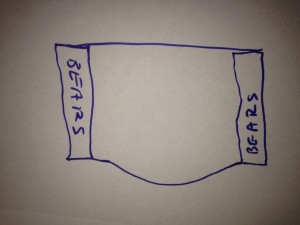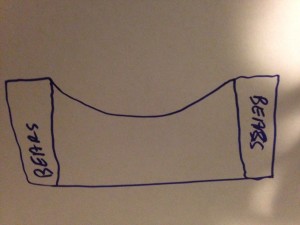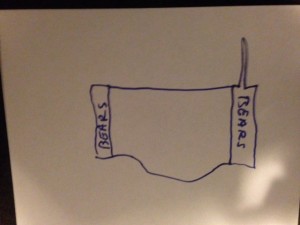Most sports, at least the good ones, are the same game with minor variations: Basketball, football, soccer, hockey, lacrosse, tennis, rugby, etc – there is a goal at each end of a rectangular shaped field and you defend your end and score on the other.
Most of these sports are horrendously boring and we need to think of some creative ways to improve them. There are various solutions being pitched, but my idea of using 2-Dimensional Field Altering Technology is by far the most interesting.
The concept is to alllow each team to bend their sideline a certain amount of feet per game, in other words, to customize their half of their field. This could be done on an iPad a few days before the game. Let’s use football as an example because it is the most boring sport with the dumbest fans and consequently the one most in need of measures which will complicate it’s strategizing and excitement level.
Assume your team has really good running backs and you want to allow them more space in the midfield. You might design your side of the field to look like this:
Or maybe your defense is really good and your offense is terrible. You could make your field look like this to reduce yardage for the opposing team:
If you quarterback is really good in the Red Zone and has a good arm, this might be your move:
These are just examples it’s tough to speculate which type of meniscus or geometrical model would properly benefit your particular team’s strengths and weaknesses. Prior to making a decision you’d have consult with a few mathematical theologists. They could even be on the coaching staff and hold clipboards. Occasionally one of them would get beaned by a stray ball and they’d fall down and it would be hilarious.
There would be countless variables to factor in: Your team’s speed, offensive vs. defensive ability, your quarterback’s dominant hand, your team’s endurance, the ability to manipulate the referees, etc.
This would benefit the sport in three ways: 1) The sports statistics morons who think they are really smart because they occasionally crunch numbers and develop useless mathematical formulas such as Positive Win Probability [STDEV = (13.45 / SQRT((60 / minutes_remaining)))] would have to acknowledge they are actually the dumb nerds and step aside. We’re working with serious theoretical functions here. 2) It would set a good example for children to visualize the impact that mathematics was making on the game. Some of them might be inspired to study quantum theory instead of bash their heads into other people. 3) Most importantly, the sport would be more visually appealing, and there would be a huge amount of interest in seeing the final model of the field, which leads me to my next point:
The above professionally drafted diagrams only showed one side of the field being altered. Obviously, each team would manipulate their field accordingly. If they so chose. The rule isn’t mandatory. The reveal of how each team had customized their side would be nearly as exciting as the game. And again as an added benefit, almost every dumbass sports radio guy would have to quit his job because he wouldn’t be able to learn the basic mathematical terminology! Here is an example of what a typical field might look like on Sunday:
If you’re going to tell me that won’t make for a more exciting game, I’m going to call you a liar.
It’s time we take the next logical step in the evolution of our popular sports. 2-Dimensional Field Altering Technology is the wave of the future.
You’re welcome.
All 2-Dimensional Models Copyright of Matt Ralston




